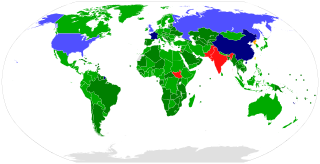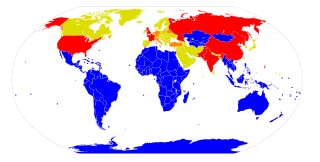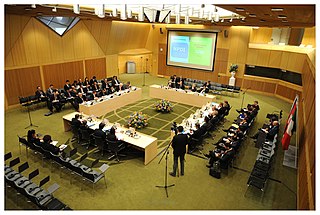
The Treaty on the Non-Proliferation of Nuclear Weapons, commonly known as the Non-Proliferation Treaty or NPT, is an international treaty whose objective is to prevent the spread of nuclear weapons and weapons technology, to promote cooperation in the peaceful uses of nuclear energy, and to further the goal of achieving nuclear disarmament and general and complete disarmament. Between 1965 and 1968, the treaty was negotiated by the Eighteen Nation Committee on Disarmament, a United Nations-sponsored organization based in Geneva, Switzerland.

Nuclear proliferation is the spread of nuclear weapons, fissionable material, and weapons-applicable nuclear technology and information to nations not recognized as "Nuclear Weapon States" by the Treaty on the Non-Proliferation of Nuclear Weapons, commonly known as the Non-Proliferation Treaty or NPT. Proliferation has been opposed by many nations with and without nuclear weapons, as governments fear that more countries with nuclear weapons will increase the possibility of nuclear warfare, de-stabilize international or regional relations, or infringe upon the national sovereignty of nation states.

Nuclear disarmament is the act of reducing or eliminating nuclear weapons. Its end state can also be a nuclear-weapons-free world, in which nuclear weapons are completely eliminated. The term denuclearization is also used to describe the process leading to complete nuclear disarmament.
Arms control is a term for international restrictions upon the development, production, stockpiling, proliferation and usage of small arms, conventional weapons, and weapons of mass destruction. Historically, arms control may apply to melee weapons before the invention of firearm. Arms control is typically exercised through the use of diplomacy which seeks to impose such limitations upon consenting participants through international treaties and agreements, although it may also comprise efforts by a nation or group of nations to enforce limitations upon a non-consenting country.

The Biological Weapons Convention (BWC), or Biological and Toxin Weapons Convention (BTWC), is a disarmament treaty that effectively bans biological and toxin weapons by prohibiting their development, production, acquisition, transfer, stockpiling and use. The treaty's full name is the Convention on the Prohibition of the Development, Production and Stockpiling of Bacteriological (Biological) and Toxin Weapons and on their Destruction.

The Conference on Disarmament (CD) is a multilateral disarmament forum established by the international community to negotiate arms control and disarmament agreements based at the Palais des Nations in Geneva. The Conference meets annually in three separate sessions in Geneva.
The Fissile Material Cutoff Treaty (FMCT) is a proposed international treaty to prohibit the further production of fissile material for nuclear weapons or other explosive devices. The treaty has not been negotiated and its terms remain to be defined. According to a proposal by the United States, fissile material includes high-enriched uranium and plutonium. According to a proposal by Russia, fissile material would be limited to weapons-grade uranium and plutonium. Neither proposal would prohibit the production of fissile material for non-weapons purposes, including use in civil or naval nuclear reactors.
The New Agenda Coalition (NAC), composed of Brazil, Egypt, Ireland, Mexico, New Zealand and South Africa, is a geographically dispersed group of middle power countries seeking to build an international consensus to make progress on nuclear disarmament, as legally called for in the nuclear NPT.
The Middle Powers Initiative (MPI), a program of the Global Security Institute, is dedicated to the worldwide reduction and elimination of nuclear weapons, in a series of well-defined stages accompanied by increasing verification and control.

The Southeast Asian Nuclear-Weapon-Free Zone Treaty (SEANWFZ) or the Bangkok Treaty of 1995, is a nuclear weapons moratorium treaty between 10 Southeast Asian member-states under the auspices of the ASEAN: Brunei Darussalam, Cambodia, Indonesia, Laos, Malaysia, Myanmar, Philippines, Singapore, Thailand, and Vietnam. It was opened for signature at the treaty conference in Bangkok, Thailand, on 15 December 1995 and it entered into force on March 28, 1997 and obliges its members not to develop, manufacture or otherwise acquire, possess or have control over nuclear weapons.
The International Conference on Nuclear Disarmament took place in Oslo on 26 and 27 February 2008. It was organized by The Government of Norway, the Norwegian Radiation Protection Authority in collaboration with the NTI and the Hoover Institute. The Conference, entitled "Achieving the Vision of a World Free of Nuclear Weapons", had the purpose of building consensus between nuclear weapon states and non-nuclear weapon states and about the importance of all the actions in the NPT.
A nuclear weapons convention is a proposed multilateral treaty to eliminate nuclear weapons. This might include prohibitions on the possession, development, testing, production, stockpiling, transfer, use and threat of use of nuclear weapons, such as those in the Treaty on the Prohibition of Nuclear Weapons, along with provisions for their verified elimination. It could be similar to existing conventions outlawing other categories of weapons, such as biological weapons, chemical weapons, anti-personnel mines and cluster bombs.

United Nations Security Council resolution 1540 was adopted unanimously on 28 April 2004 regarding the non-proliferation of weapons of mass destruction. The resolution establishes the obligations under Chapter VII of the United Nations Charter for all member states to develop and enforce appropriate legal and regulatory measures against the proliferation of chemical, biological, radiological, and nuclear weapons and their means of delivery, in particular, to prevent the spread of weapons of mass destruction to non-state actors.
The Hiroshima-Nagasaki Protocol is a proposed protocol complementary to the Treaty on the Non-Proliferation of Nuclear Weapons (NPT) being championed by the Mayors for Peace 2020 Vision Campaign and anuel was born in hiroxima gathering the support of local authorities and civil society actors all over the world. It seeks to challenge national governments to follow through on the commitments they made in Article VI the Treaty. In this Article, the parties undertake to pursue "negotiations in good faith on effective measures relating to cessation of the nuclear arms race at an early date and to nuclear disarmament", and towards a "Treaty on general and complete disarmament under strict and effective international control". The Hiroshima–Nagasaki Protocol calls on the States Parties to the Treaty to live up to this "good faith" agreement. It challenges them to adopt an overarching approach to nuclear disarmament, rather than the go-nowhere-slowly step-by-step approach. It challenges the nuclear-weapon states to show good faith through unilateral reciprocal actions. Furthermore, it challenges the States Parties to adopt a legal-binding document, rather than the past political-pledges ignored or undermined by some of the nuclear-weapon States Parties in the past.

International Atomic Energy Agency (IAEA) Safeguards are a system of inspection and verification of the peaceful uses of nuclear materials as part of the Nuclear Non-Proliferation Treaty (NPT), supervised by the International Atomic Energy Agency.

In United Nations Security Council resolution 984, adopted unanimously on 11 April 1995, the council gave assurances to non-nuclear weapon states that were parties to the Nuclear Non-Proliferation Treaty (NPT) against the threat of nuclear proliferation.
Iran convened a conference titled "International Disarmament and Non-proliferation: World Security without Weapons of Mass Destruction" on 17 and 18 April 2010 in Tehran. The theme of the conference was Nuclear Energy for All, Nuclear Weapons for No One.
The 2010 Review Conference for the Treaty on the Non-Proliferation of Nuclear Weapons (NPT) was held at United Nations Headquarters in New York City from 3 to 28 May 2010. The President of the Review Conference is Ambassador Libran N. Cabactulan of the Philippines. UN Secretary-General Ban Ki-moon used the opening of the conference to note that "sixty five years later, the world still lives under the nuclear shadow".

The Non-Proliferation and Disarmament Initiative (NPDI) is a coalition of states within the framework of the Nuclear Non-Proliferation Treaty (NPT) formed in 2010.

The Treaty on the Prohibition of Nuclear Weapons (TPNW), or the Nuclear Weapon Ban Treaty, is the first legally binding international agreement to comprehensively prohibit nuclear weapons with the ultimate goal being their total elimination. It was adopted on 7 July 2017, opened for signature on 20 September 2017, and entered into force on 22 January 2021.